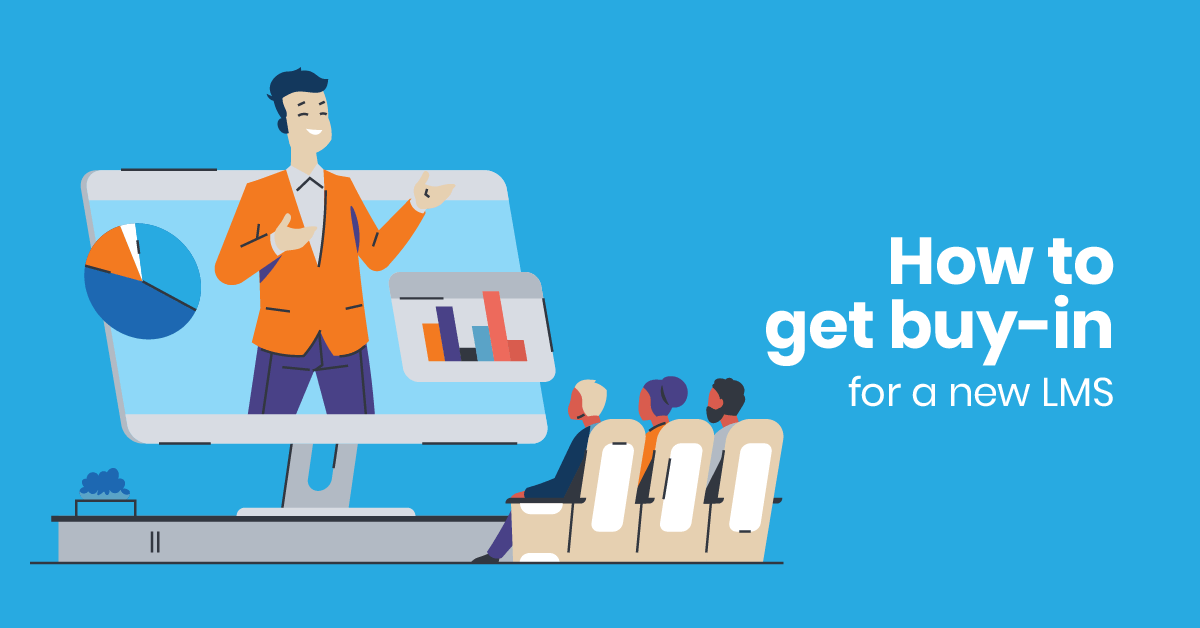That’s one of the rules of effective storytelling — but it’s also applicable when it comes to making an LMS business case to present to your boss.
Because yes, you know that a new LMS will be a valuable tool for your company. You know that continuous learning makes for engaged and better-performing employees. And you know that managing your eLearning content through a corporate LMS is convenient, scalable, and much less of a headache than any other alternative.
But to convince your boss and other stakeholders, who are probably busy or skeptical, you need to do more than telling them what you know.
You need to show them. Using concrete arguments that will cut to the point. And using terms they understand —and care— about.
If you’re not sure how to start building your LMS business case, this article will help.
Support your LMS business case with the appropriate arguments
When building your LMS business case, it’s important to use arguments that will “speak” to your boss and stakeholders. Start with the more practical ones first (aka how an LMS saves money and time) and leave the more “emotional” ones for later in your presentation.
Use this list below as your cliff notes to get the LMS buy-in you’re looking for.
Argument #1: Buying an LMS will help cut costs
It’s a truth universally acknowledged that the first question that springs to a CEO’s mind when presented with a new technology to invest in, is “how much”. How much will this new technology cost to acquire — and how much money can it potentially help them save. Thankfully, the numbers are on your side.
Buying an LMS helps cut both training and admin costs.
Your LMS purchase will require a monthly or annual fee and, in some cases, an upfront, one-off implementation cost — but it will be the gift that keeps on giving. In contrast to in-person training, eLearning delivered through your new LMS will be recorded and able to be repurposed as needed.
This will save your company money in the long run, when there will be a new batch of employees to train. It will also help employees to revisit training materials as needed, ensuring they absorb knowledge and perform better.
Another way a corporate LMS will help cut costs is via its many different features and integrations. For example, by helping track performance (we’ll elaborate on that later) and enforcing compliance-related initiatives, an LMS can save a company thousands of dollars on compliance fines. And by integrating your LMS with a videoconferencing tool like Zoom, you can facilitate company-wide communication and avoid costly misunderstandings.
Tip: To ensure getting an LMS buy-in, it’s important to do the math and be specific. Find out how much the LMS costs and (if you have access to that data) calculate how much money the company is spending now on training and onboarding. Make these numbers a prominent part of your presentation.

Argument #2: With a new LMS, you nail onboarding — even remotely
To stand out from competitors, attract and retain top talent you need to build the proper foundation from the start — and keep employees engaged in the long run.
But attracting and retaining top talent costs money. According to the Work Institute, employee retention and engagement consulting firm, each employee departure costs about one-third of that employee’s annual earnings. And with as much as one-third of new hires leave their position within the first six months, getting onboarding right becomes more important than ever.
Onboarding is more than just letting new hires know about their responsibilities. It’s your opportunity to make them aware of the company culture, mission, and values from the get-go. It’s also a great opportunity for new hires to meet and socialize with their peers and managers.
How to manage all that when everyone is working remotely? Through your new LMS.
An LMS saves money and time by automating the new hire onboarding process. Especially if you opt for a corporate LMS that can be integrated with other tools, like an email marketing platform. That way, you can easily set up a welcome campaign to help orientate new hires and point them to some early reading material.
There’s also the option, through your new LMS, to assign a buddy/mentor to every new hire. This will help new employees have a smoother digital introduction to the team and not feel overwhelmed or isolated.
Argument #3: An LMS makes training data collection a breeze
Remote working and training have brought up an increased need for capturing data about productivity and engagement but also mental health and wellness. And the trend is not likely to go away. A Gartner report on trends for the future of the workplace after COVID-19 sees an increase in data collection overall.
Your new LMS can help your company keep up with that trend.
From generating data on training and engagement to providing frequent updates to your boss and upper management, LMS reporting is a time-saving tool. You don’t have to think about collecting data — it’s done automatically.
And by investing in a corporate LMS like eFront, you can schedule and automatically send reports at a certain frequency to a list of recipients. This will make giving periodic status updates that much simpler.
Argument #4: It will strengthen company culture amidst the pandemic
According to a recent SHRM research, 2 in 3 employers say maintaining employee morale has been a challenge. This is particularly the case for companies with a large number of employees.
It’s not hard to see why. For so many employees out there, the pandemic has compounded their already elevated stress levels. They have to deal with issues at home and with uncertainty at work.
Strengthening company culture, and, consequently, employee morale, should be one of your boss’s priorities. But how does an LMS tie into that, your boss might ask?
Ben DeSpain, Chief People Officer of Velocity, notes in a Forbes article that using an LMS for training is key in achieving that morale boost, especially for connecting with new hires who are not familiar with the company culture yet. It’s true that through eLearning, especially through gamified eLearning, employees can socialize and bond. Collecting points and badges and being featured on leaderboards can do wonders for promoting playful competition.
Plus, with your LMS’s communication tools, employees can interact with each other, e.g., via internal emails, discussion forums, and comments. That way, employees can counteract any sentiments of isolation caused by remote working and feel once again engaged and included in your company culture.
And they can learn better, by learning together.
Argument #5: Building trust among employees leads to growth
So you’ve already established that a corporate LMS can boost morale and give company culture a helping hand… but why should your boss care?
The answer is simple: because there’s a direct path between employee engagement and company growth. An engaged employee is an employee who trusts that the company they work for wants them to succeed and grow as individuals. And according to a Gallup and TrueSpace study, companies with high levels of trust among their employees are 2.7 times more likely to hit their growth goals.
Investing in eLearning, which is what your LMS business case is about, essentially helps your boss create a reliable, engaged workforce that will contribute to growth. A workforce that keeps acquiring and polishing critical skills that can help them navigate change and function in many different roles within the company.
This is important now — but it will be even more important post-pandemic.
How to wrap it all up
Presenting your LMS business case to your boss and stakeholders can feel like a lot. But the more well prepared you are, the more chances you have to make them see things your way. To that end, including some slides with numbers and infographics can go a long way.
As will scheduling a demo, so that your boss can see first-hand your platform of choice.
Booking a demo with eFront is easy and free — and it will make all the difference between “telling” and “showing”.



